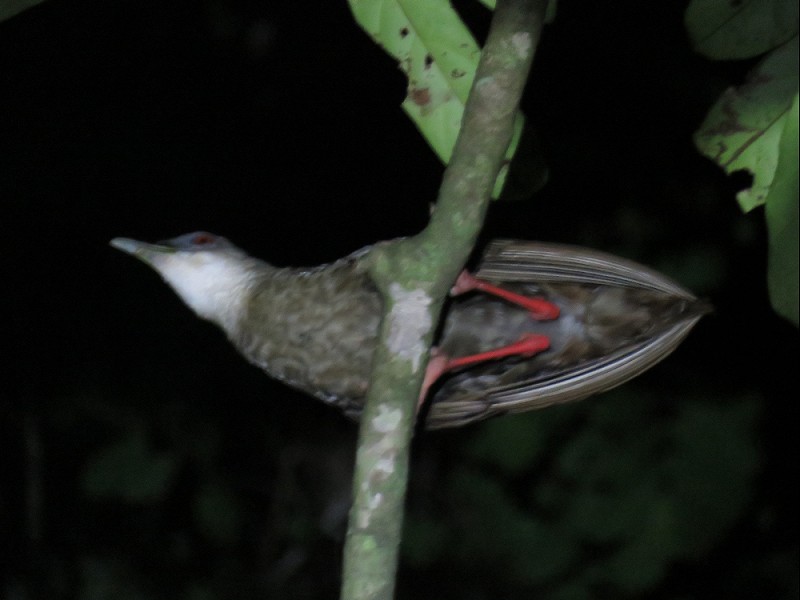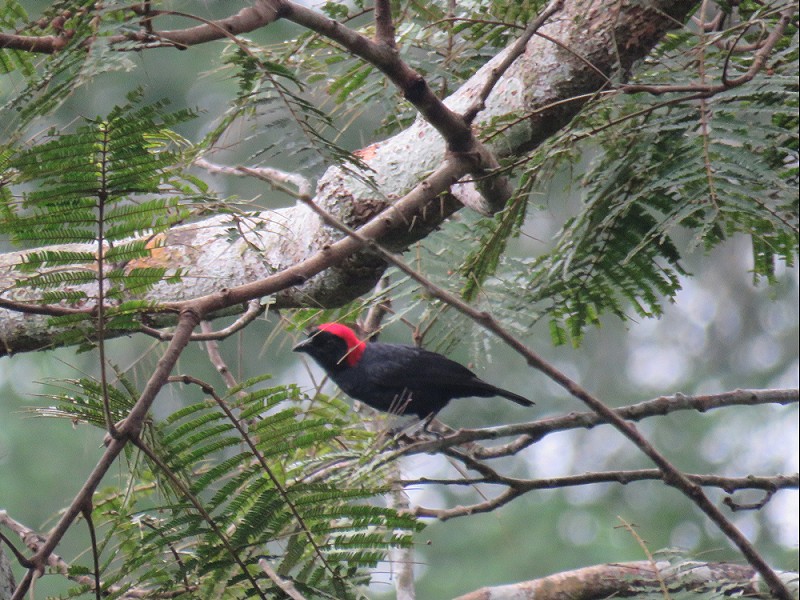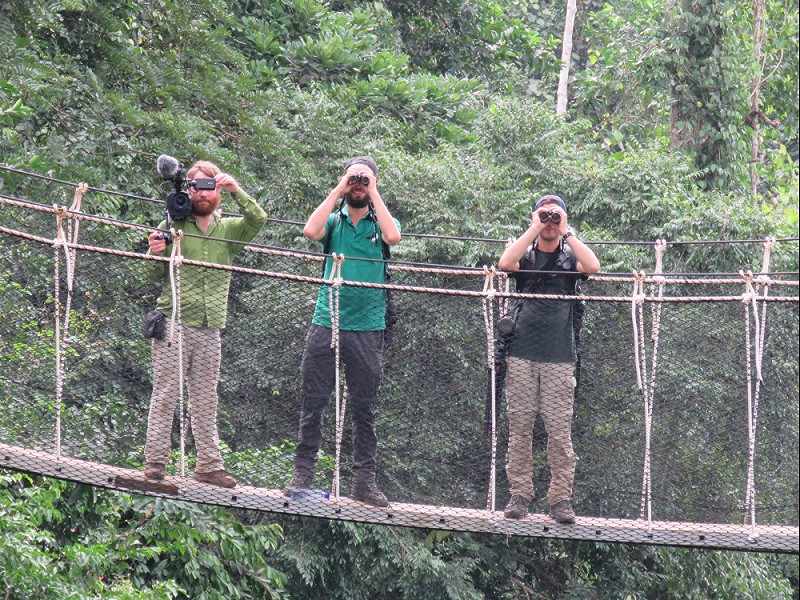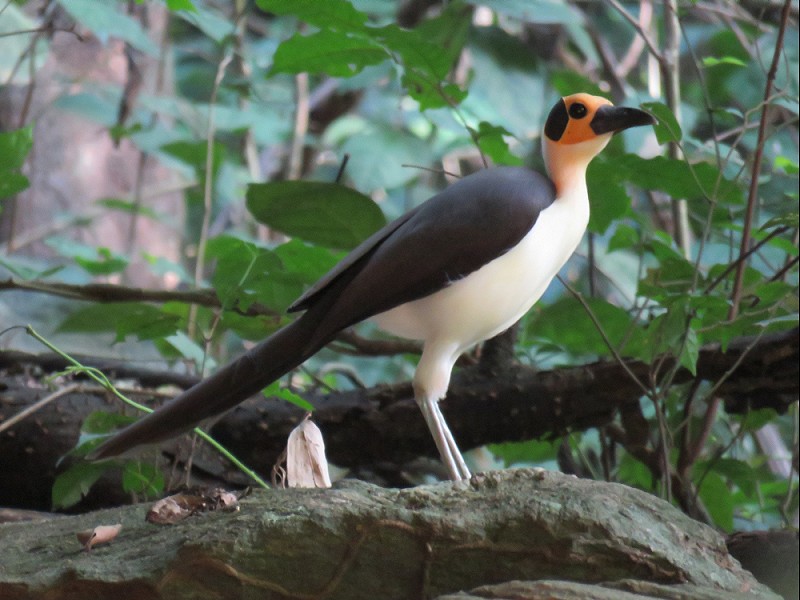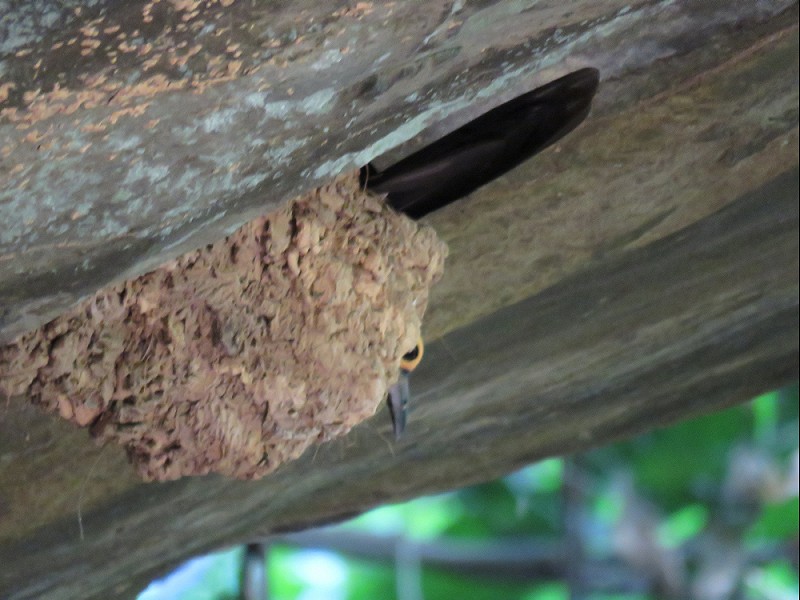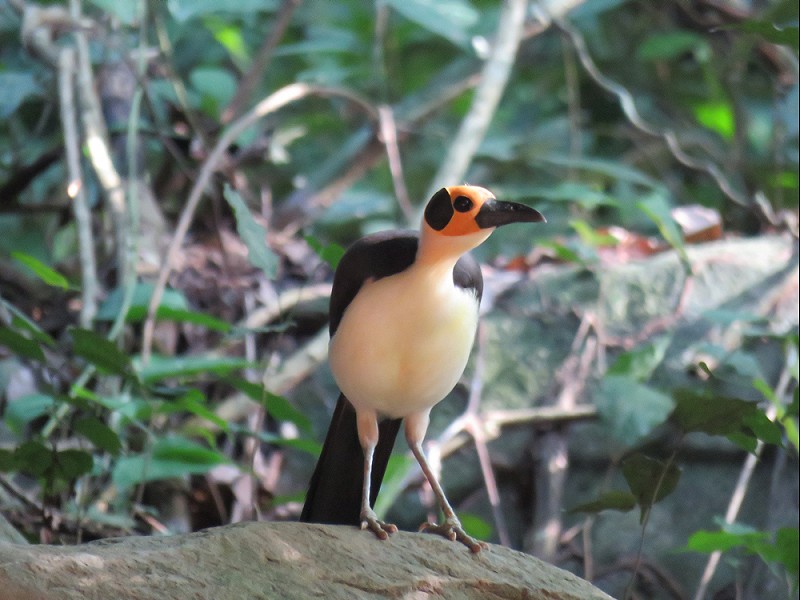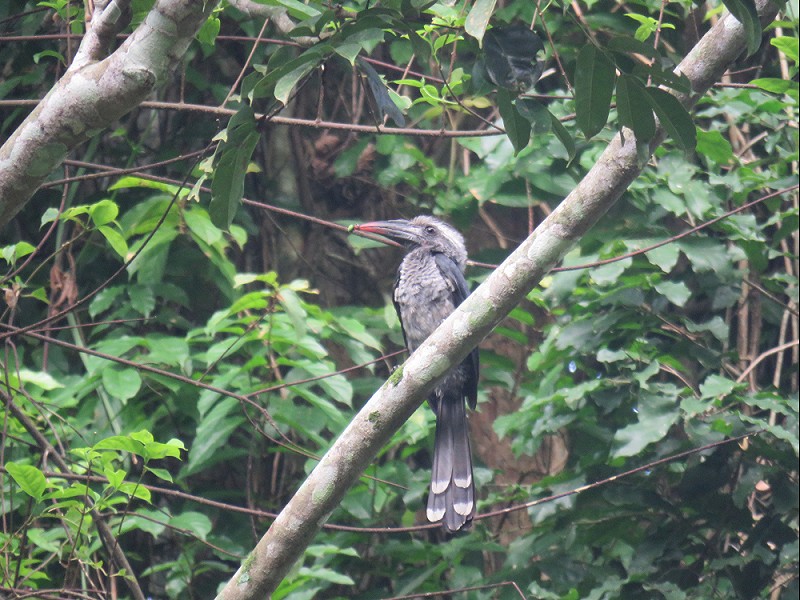June 16 - 23
28 June 2016 · Arjan Dwarshuis · 7884 × bekeken
PLEASE MAKE A DONATION NOW!
world.observation.org/arjan
www.arjandwarshuis.com/#biggestyear
June 16th IN TRANSIT
At 6 AM I said goodbye to Camilla, drove to Cape Town Airport and boarded my flight to Accra, Ghana. There was no other option than an early flight with a layover in Johannesburg, so I was doomed to spend almost the entire day on a plane.
I arrived around 17:30 PM in Accra, just in time to do half an hour of birding around the airport with William and Paul, two of Ashanti African Tours best guides. Ahanti African Tours had sponsored 12 days of fantastic birding around Ghana for me, my dad, his friend Loek and the Biggest Year film crew comprised of director Michiel van den Bergh and cameraman John Treffer, all to support my Biggest Year!
I had a couple of hours to kill before the rest arrived and during that time I managed to fortunately locate a single new bird, Yellow-billed Shrike, making sure I didn’t get another zero day :)
After the rest had arrived we drove straight to the Rainforest Lodge at the edge of Kakum NP, where we quickly went to bed to catch a couple of hours of much needed sleep before our first morning birding session.
June 17th BACK IN THE RAINFOREST
We woke up to clear skies – a rare sight for Ghana in the middle of the rainy season – and drove the short distance to the ‘Kakum Square’, a block of rainforest opposite the Kakum National Park. I was feeling the excitement as we approached the rainforest edge since this was my first time ever birding the Upper Guinea biome.
As we set foot on a beautiful quiet trail through the forest it quickly became clear that both William and Paul knew their sounds exceptionally well. They picked up one amazing species after another and we had some great sightings within our first hours in the Upper Guinea rainforest. Personal highlights were Rufous-sided Broadbill, Tiny Sunbird, a calling Congo Serpent Eagle and a fantastic female Black Casqued Hornbill. By the end of the morning I had plussed 20 new species!
After lunch we headed east towards Ankasa Forest, one of the most pristine stretches of primary forest in Ghana, right at the boarder of Ivory Coast. En Route we made several stops at the many stakeouts that Paul and Willam had lined up for us, this resulted in a male Black-bellied Seedcracker (one of my most wanted species here), the localized Reichenbach’s Sunbird and nesting Orange Weavers.
At Ankasa Forest we were welcomed by chief resources guard Kenneth Frank Eshun who would be our host for the next few days. After dark we made a night drive across the main dirt road that runs through the forest. You could see that the weather had been horrendous lately since there were deep pools next to and even on the road and there were fallen trees every hundred meters or so, how lucky were we with the weather now!! The highlight that evening was a Dwarf Crocodile (or Caiman) in a puddle on the road.
June 18th A FULL DAY IN ANKASA FOREST
We had a very early start today, around 4 AM we were on our way to the forest. The reason for this early start were the many fantastic night birds of Ankasa forest, in particular the Akun Eagle-Owl and the near mythical Nkulengu Rail. The latter can only be found by chasing after its bizarre pre-dawn booming duet.
We heard both birds during our morning owling session, but the Akun Eagle Owl refused to come in - despite calling persistently from fairly nearby - and the Nuklengu Rail called from too far to even try.
While we had breakfast a Red-chested Goshawk announced itself as our first new seen bird for today and after this early success we were off into the forest with Paul and William and of course Kenneth.
Ankasa Forest surely is beautiful and in many areas there are still some huge ‘forest giants’ dwarfing the surrounding secondary forest, but like many rainforests in Africa this place is under pressure. Quite recently the corridor linking Ankasa with its Ivory Coast counterpart has been destroyed limiting the gene flow between larger animals. This of course has a devastating impact on the forest. Luckily Kenneth assured me that the Ghanese Forest Department is promoting community based conservation in Ankasa and subsequently poaching and illegal logging has become less frequent.
Our full day birding in Ankasa was absolutely fantastic with cracking birds like Red-tighted Sparrowhawk, a pair of Hartlaub’s Duck, Johanna’s Sunbird, Willcock’s Honeyguide, Cassin’s Hawk-eagle and Red-fronted Antpecker.
June 19th TRACKING DOWN THE NKULENGU RAIL
At 4 AM this morning Michiel and I went on a mission, we had to find the Nkulengu Rail, for both of us one of our most wanted Ghanese specialties. Like yesterday Paul, William and the two of us were waiting for the Rail to deliver its pre-dawn duet…
Suddenly a rail began to call and after roughly pinpointing the sound we raced into the pitch-black forest across a small trail in the direction of the sound. Miraculously the trail went roughly in the right direction and before we knew there was just 50 meters of forest between us and the bird, but then he stopped calling, a tense 5 minutes of waiting… He started to call once more! We raced in, but when we were just 10 or 20 meters away from the bird it stopped calling again. We all started spotlighting the surrounding trees and then suddenly Paul had found it! Yes! For the next 10 minutes Chiel and I had amazing views of a Nkulengu Rail – with a calling Latham’s Francolin in the background - perching right above our heads, a magical moment.
At breakfast we were joined by Loek and my dad again and together we spent two more hours on the trail that runs through the beautiful ‘bamboo cathedral’, a nice finally to our stay in Ankasa – with still no rain :)
In the afternoon we picked up John Treffer, the cameraman of the Biggest Year documentary and we had a fantastic first afternoon of filming in the moist Savannah near Bremu beach, with breeding plumaged Bishops, Whyda’s and Widdowbirds displaying all over the place, great stuff for the big screen.
June 20th WALKING THROUGH THE TREE TOPS AND SLEEPING IN THE CANOPY
Kakum NP is home to Ghana’s most amazing tourist attraction, the Kakum Canopy Walk. This architectural masterpiece comprises a series of suspension bridges connecting 7 wooden platforms at up to 40 meters altitude in the rainforest canopy. For any human being without a fright of heights this a once in a lifetime experience, but for a birdwatcher it is even more special since you have the opportunity to study birds that you normally see as small dots 40 meters above you at eyelevel!
As we walked up to the start of the canopy walk with our local guide Stephen Apana we had a slight delay because we bumped into a calling African Piculet, a rare bird and the only African member of this genus.
At the start of the walkway we unfortunately had to leave Loek behind because he appeared to have a terrible fright of heights. Luckily it was not a big deal for him and he still wanted us to have the experience of a lifetime, so well done man!
In addition to birding we did a lot of filming for the Biggest Year Film and by some miracle it stayed dry all day enabling Michiel and John to shoot some great footage in an amazing setting. Birding was also great with cracking species like Brown-cheeked Hornbill, West African Batis, Violet-backed Hyliota and Little Green Woodpecker, but the best experience was having a mega canopy flock of 20+ species feeding right below us in perfect light conditions, a unique experience only possible at a place like this.
At dusk we took our luggage to the ‘tree house’. As the name suggest the tree house is a campsite at more than 10 meters altitude in the middle of the rainforest. A unique way to experience sleeping in the forest, but bed time was still far away since we first had to track down some of Kakum’s fantastic night birds. We started with seeing (!) a perched Brown Nightjar from the walkway, but the highlights were still to come as we finished our owling session with stupendous views of both Akun- and Fraser’s Eagle-owl, both birds were captured on film by John!
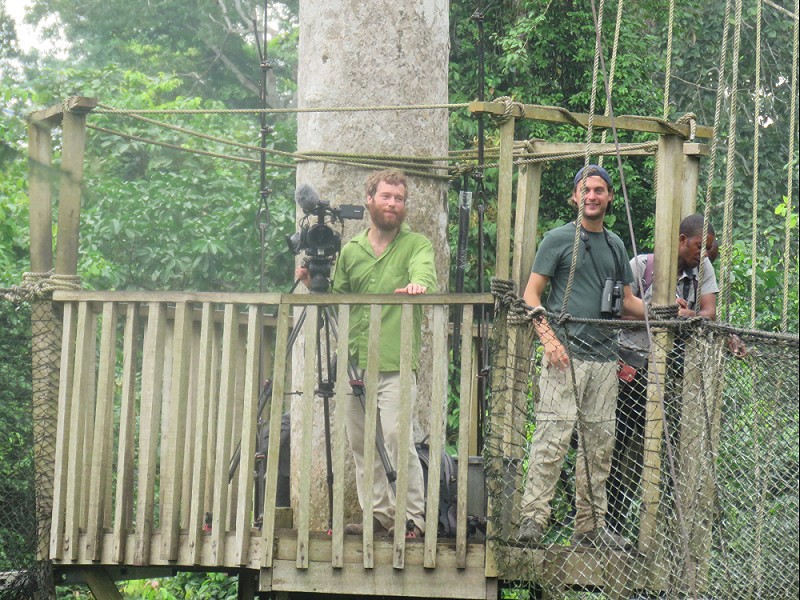 Cameraman John Treffer and director and producer Michiel vd Bergh on the Kakum Canopy Walkway (Arjan Dwarshuis)
Cameraman John Treffer and director and producer Michiel vd Bergh on the Kakum Canopy Walkway (Arjan Dwarshuis)
June 21st HORNBILLS!
Because the weather was still perfect when we woke up in the rainforest canopy we decided to take the opportunity to have one more morning of filming from the canopy walk. Mist trough the treetops, calling birds in the background and Spot-nosed Monkeys feeding down below us made for a fantastic setting. The absolute highlights however were the hornbills. We had amazing views – and footage – of a preening pair of White-crested Hornbill and multiple sightings of Brown-cheeked Hornbills. It is a privilege to still see good numbers hornbills, since this family is most vulnerable to logging; they have large territories and use big rainforest trees for nesting.
At lunch we momentarily said goodbye to Chiel, John and Paul who went ahead to film the White-necked Rockfowl at its nesting sight. My dad, Loek and I would follow tomorrow. We went to the Offinso Forest with William. Birding was a little bit slow, but we did manage to get views of Copper-tailed Starling and we heard the rare Green-tailed Bristebill. Best however was a fly-by Yellow-casqued Hornbill and as dusk fell a gripping Fraser’s Eagle-owl showed up in the spotlight.
June 22th IN SEARCH OF THE PICATHARTESToday was D-day, we would have our shot to come face-to-face with Ghana’s most legendary bird, the White-necked Rockfowl or Picathartes; made famous more than 50 years ago by David Attenborough in a BBC documentary where he filmed these bizarre birds attending their equally bizarre mud-cup nest that hangs from a rock face. Today we would follow in Attenborough’s footsteps!
Before we set off to Bonkro village – gateway to the Picathartes breeding site – we had a productive morning birding session with William which produced sightings of Red-cheeked Wattle-eye, Kemp’s Longbill and the exquisite White-bibbed Swallow.
Before we arrived at Bonkro village we had a look at the school that is currently being build and financed by Ashanti African Tours. This school – which will be finished May 2017 – will provide schooling for hundreds of children from the neighbouring villages and countryside, a fantastic initiative by Ashanti and the perfect example how ecotourism can benefit local communities. In addition to this, Ashanti is almost finished building a visitors centre and sponsors the local football team. In my opinion they set the example for tour companies worldwide.
After a festive welcome ceremony in the village – with music, dance performances and a football match by the Ashanti sponsored team – and paying an entrance and guiding fee to the community, we set off into the forest with two local guides. After 20 minutes of walking we paused at which point Paul told us to be death quiet from that point on, we had entered the realm of the Picathartes. By now you could feel the excitement in the air and you could see the tension on everyone their faces.
After another 15 minutes’ walk we approached an overhanging rock face and as we got closer we saw two large mud-cup nest attached to the rock, like a huge version of a House Martin’s nest. We sat down and waited, 20 minutes passed and nothing happened, but then suddenly there was a movement to the right of us. Paul whispered ‘PICATHARTES!’ and two huge prehistoric looking birds hopped into view, barely 10 meters from where we were sitting. I could hardly believe my eyes, the immaculate grey-and-white plumage and that utterly strange and simultaneously beautiful bald yellow-and-black head. What a magnificent bird!
We watched and filmed these birds for a full hour attending their nest making this my best sighting of my Biggest Year so far and maybe even my life. And I tell you, we got some mouth-watering footage, a reason alone to come see the documentary upon completion!
June 23th HEADING NORTH
Last evening we had driven to a lodge in the middle of the Boberi Forest and this morning we woke up amidst a wall of green with calling Grey Parrots in the background, fantastic!
Our morning session in this stunning primary forest was quiet productive with good views of both Red-billed- and Black Dwarf Hornbill, African Piculet, a displaying African Cuckoo-hawk and both Western bronze-naped and Afep Pigeon.
At 10 AM it was time to head north to the savannah of Mole National Park, a very long drive, which would take us all day.
Arjan Dwarshuis
PLEASE MAKE A DONATION NOW!
world.observation.org/arjan
www.arjandwarshuis.com/#biggestyear
Discussie
Jurgen van der Meer
·
28 June 2016 21:34
magische vogels! En een prachtig verslag.
Eduard Sangster
·
29 June 2016 12:32
Mooi verslag, wederom!
Mason Dillon
·
2 April 2020 22:28
Hello, thanks a lot
Gebruikers van het forum gaan akkoord met de forumregels.


